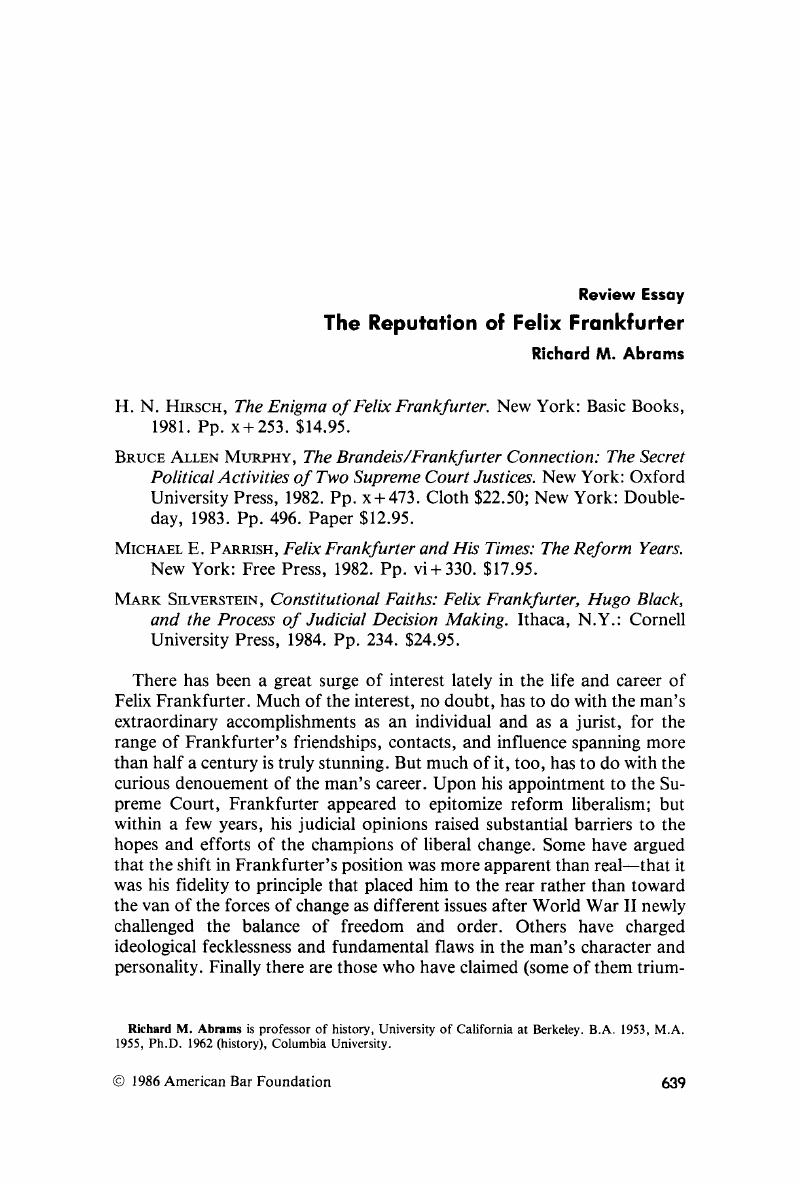No CrossRef data available.
Article contents
The Reputation of Felix Frankfurter
Review products
Published online by Cambridge University Press: 20 November 2018
Abstract

Information
- Type
- Review Essays
- Information
- Copyright
- Copyright © American Bar Foundation, 1985
References
1 Minersville School Dist. v. Gobitis, 310 U.S. 586 (1940).Google Scholar
2 See R. M. Abrams, The Burdens of Progress 19, 24–27 (Glenview, Ill.: Scott, Foreman & Co., 1978); and id., Free and Equal: As Compared to What? Revs. Am. Hist., Mar. 1981, at 97–105.Google Scholar
3 Murphy, Paul, The Meaning of Freedom of Speech: First Amendment Freedoms from Wilson to FDR 12 (Westport, Conn.: Greenwood Publishing Co., 1972).Google Scholar
4 United States v. Carolene Prods. Co., 304 U.S. 144, 152 n.4 (1938). See Alpheus Thomas Mason, Harlan Fiske Stone: Pillar of the Law 513 (New York: Viking Press, 1956); and Silverstein (at 134–35).Google Scholar
5 NLRB v. Jones & Laughlin Steel Corp., 301 U.S. 58 (1937); and West Coast Hotel Co. v. Parrish, 300 US. 379 (1937).Google Scholar
6 Stone's memorandum to Hughes is printed in Silverstein (at 134–35).Google Scholar
7 Meyer v. Nebraska, 262 U.S. 390 (1923).Google Scholar
8 Hitchman Coal & Coke Co. v. Mitchell, 245 U.S. 229 (1917); Truax v. Corrigan, 257 U.S. 312 (1921); Adkins v. Children's Hosp., 261 U.S. 525 (1923). In Hitchman, the Court had treated union organizers as conspirators bent on inducing workers to break their contracts; in Truax, it had voided an Arizona statute forbidding the use of court injunctions against peaceful picketing; and in Adkins, which Frankfurter had himself argued before the Court, it threw out an act passed by Congress setting minimum wages for women in the District of Columbia.Google Scholar
9 From Cardozo's majority opinion in Palko v. Connecticut, 302 U.S. 319, 325–26 (1937).Google Scholar
10 Dennis v. United States, 341 U.S. 494, 544 (1951), in which the Court upheld conviction, under provisions of the Smith Act (1940), of ten Communist party leaders of conspiracy to advocate the overthrow of the government by force or violence.Google Scholar
11 Minersville School Dist. v. Gobitis, 310 U.S. 586 (1940).Google Scholar
12 Id. at 596. The argument here was a virtual replay of Frankfurter's views on Holmes's dissent in the Meyer case, 266 US. at 390.Google Scholar
13 In the course of breaking a mine strike in the summer of 1917, mine owners outraged even conservative American sensibilities by forcibly loading over a thousand strikers and their sympathizers into cattle cars, hauling them into the New Mexico desert, and abandoning them without food or water.Google Scholar
14 Mooney, a labor organizer, had been railroaded to prison, charged with a fatal San Francisco bombing in July 1916, on what Frankfurter found to be perjured testimony.Google Scholar
15 Soviet espionage almost certainly had already revealed the research to Stalin, though Bohr could not have known that.Google Scholar
16 Millis, Walter, ed., The Forrestal Diaries (New York: Viking Press, 1951). James Forrestal was Truman's first secretary of defense.Google Scholar
17 See Baker, Leonard, Brandeis and Frankfurter: A Dual Biography (New York: Harper & Row, 1984), for a more balanced and mature account of the relationship and evidence that the activities of the two were widely understood, even among some of their enemies.Google Scholar
18 See R. M. Abrams, Conservatism in a Progressive Era: Massachusetts Politics, 1900–1912 at 60 (Cambridge: Harvard University Press, 1964).CrossRefGoogle Scholar

